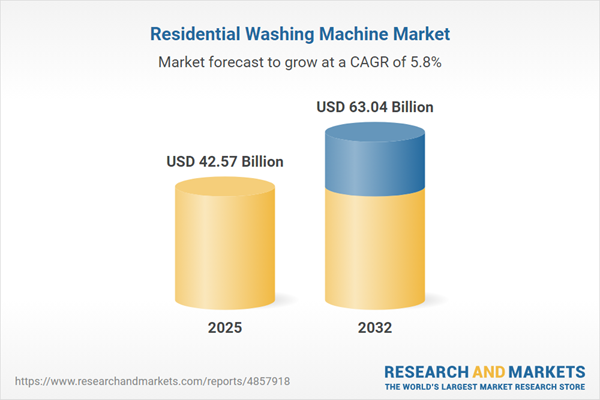Speak directly to the analyst to clarify any post sales queries you may have.
Senior decision-makers in the home appliance sector navigate a rapidly evolving landscape where shifting technical, consumer, and regulatory trends continually influence the residential washing machine market. This creates a critical need for comprehensive, actionable insights that inform strategic operational choices and drive sustainable growth.
Market Snapshot: Residential Washing Machine Market Size, Growth, and Drivers
The residential washing machine market is poised for sustained expansion, with a projected increase from USD 40.19 billion in 2024 to USD 42.57 billion in 2025, ultimately reaching USD 63.04 billion by 2032. The market’s compound annual growth rate (CAGR) stands at 5.78%. Increasing demand for energy-saving appliances and the integration of smart technologies are central forces accelerating market adoption. Evolving regulatory mandates coupled with dynamic consumer expectations drive continuous development. Industry leaders are focusing on digital transformation to reinforce their competitive positions and adapt business models. Diverse sales and engagement channels, both digital and in-person, are pivotal for broadening market impact.
Scope & Segmentation in the Residential Washing Machine Market
- Product Type: Fully automatic washing machines appeal to users seeking reduced manual input and optimized convenience, while semi-automatic models provide accessible solutions for cost-sensitive consumers and areas with variable utilities.
- Capacity: Compact units address space constraints in urban settings, whereas high-capacity machines cater to large households, communal residences, and institutional environments.
- Energy Rating: High-efficiency appliances resonate with end-users prioritizing sustainability and regulatory conformity, becoming increasingly essential for both manufacturers and consumers.
- Price Range: Budget-focused buyers seek entry-level machines, while premium segments are characterized by investments in durability and advanced features.
- Design Type: Front load models offer water and energy savings, supporting ecological goals; top load machines provide straightforward controls suitable for fast-paced lifestyles.
- Distribution Channel: Online platforms facilitate customized, direct purchasing and sustained brand engagement, while physical retail outlets remain important for personalized consultation and product verification.
- Regions Covered: Regional dynamics differ markedly across Americas, Europe, Middle East & Africa, and Asia-Pacific, each shaped by distinct regulatory environments and consumption trends. Markets such as the United States, Germany, China, India, and Australia display unique adoption motivators and market requirements.
- Key Companies Analyzed: Industry analysis includes leaders such as Godrej & Boyce Manufacturing, Bosch, Haier, IFB Appliances, LG Electronics, Panasonic, Samsung, Whirlpool, Electrolux, and General Electric, each evaluated for strategic and innovative positioning.
Key Takeaways for Senior Decision Makers
- Smart feature integration, such as app-based controls and programmable wash cycles, positions brands to match evolving user needs and differentiate in highly competitive markets.
- Introduction of innovative components—including inverter motors and dosing automation—drives both operational efficiency and improved compliance, while enabling cost savings across product life cycles.
- Accelerating digital transformation efforts in direct-to-consumer sales and aftersales support ensures companies can quickly respond to changing purchasing preferences and service expectations.
- Diversifying product designs enables coverage of multiple use scenarios, from single-occupancy apartments to group-living and institutional settings, broadening the manufacturer’s market reach.
- Collaborative supply chain strategies, including alliances and tighter integration, enhance risk management and secure operations when facing regulatory fluctuations and unexpected market interruptions.
Tariff Impact and Strategic Response
The recent imposition of tariffs by the United States on imported washing machines and key components has prompted industry leaders to pursue strategic changes in their sourcing approaches. Many manufacturers are now focusing on increasing domestic production or integrating supply chains vertically, in an effort to reduce reliance on global imports and increase agility in navigating trade uncertainties.
Methodology & Data Sources
This report draws on executive interviews from manufacturing, retail, and logistics segments, critical assessment of technical documents, shipment analysis, and current regulatory developments. This robust methodology delivers clear, actionable perspectives for strategic planning by senior executives.
Why This Report Matters
- Empowers leadership teams to align technology adoption and compliance with the evolving demands of both the industry and diverse stakeholder groups.
- Delivers in-depth segmentation analysis and competitor benchmarking to underpin informed product innovation and regulatory strategies.
- Guides organizations in optimizing supply chain operations to meet changing market conditions, driving enhanced resilience and operational flexibility.
Conclusion
Senior leaders can rely on this analysis for guidance through the shifting landscape of technology, regulation, and consumer behavior, supporting continued organizational strength within the residential washing machine industry.
Additional Product Information:
- Purchase of this report includes 1 year online access with quarterly updates.
- This report can be updated on request. Please contact our Customer Experience team using the Ask a Question widget on our website.
Table of Contents
3. Executive Summary
4. Market Overview
7. Cumulative Impact of Artificial Intelligence 2025
Companies Mentioned
The companies profiled in this Residential Washing Machine market report include:- Godrej & Boyce Manufacturing Company Limited
- Robert Bosch GmbH
- Haier Inc.
- IFB Appliances
- LG Electronics Inc.
- Panasonic Holding Corporation
- Samsung Electronics Co, Ltd.
- Whirlpool Corporation
- Electrolux AB
- General Electric Company
Table Information
| Report Attribute | Details |
|---|---|
| No. of Pages | 193 |
| Published | October 2025 |
| Forecast Period | 2025 - 2032 |
| Estimated Market Value ( USD | $ 42.57 Billion |
| Forecasted Market Value ( USD | $ 63.04 Billion |
| Compound Annual Growth Rate | 5.7% |
| Regions Covered | Global |
| No. of Companies Mentioned | 11 |









